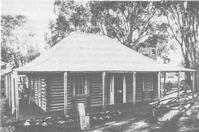


Chapter 6
I Construction During The Settlement Years
II The Use Of Timber As A Structural Material
III Structural Steel
IV Concrete Technology
V Housing
i First Settlement Technology
ii Development of the Industry
iii The Adoption of Solar Energy for Water Heating
iv Most Favourable Construction Productivity
v Housing in Cyclone Prone Localities
VI Industrialised Pre-cast Concrete Housing
VII Ports And Harbours
VIII Roads
IX Heavy Foundations
X Bridges
XI Sewerage
XII Water Engineering
XIII Railways
XIV Major Buildings
XV Airports
XVI Thermal Power Stations
XVII Materials Handling
XVIII Oil Industry
XIX The Snowy Mountains Scheme
XX The Sydney Opera House
XXI The Sydney Harbour Bridge
XXII Hamersley Iron
XXIII North West Shelf
Sources and References
Index
Search
Help
Contact us

First Settlement Technology
Early Australian houses were very primitive, and ranged from bough shelters with only a roof and no walls through to bush and bark huts, log cabins, slab, wattle-and-daub, thatched and sod huts. Since there was an abundant supply of timber, it was used for walls, roofs, floors, doors, windows and even chimneys (Fig. 13).

Then by the middle of the 1800s, because of substantial deposits of good clays, a number of brick works had come into production, supplying a small but growing population. Due to the influx of stonemasons amongst the swelling tide of immigrants, stone buildings, particularly in the southern States, were quite common in the early years.
People in Bright Sparcs - Rowell, L. E.
 |
Australian Academy of Technological Sciences and Engineering |  |
© 1988 Print Edition page 332, Online Edition 2000
Published by Australian Science and Technology Heritage Centre, using the Web Academic Resource Publisher
http://www.austehc.unimelb.edu.au/tia/331.html